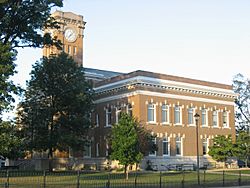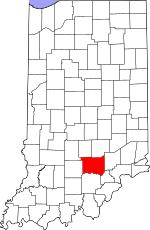Jackson County, Indiana facts for kids
Quick facts for kids
Jackson County
|
|
|---|---|

Southern face of Jackson County Courthouse in Brownstown
|
|

Location within the U.S. state of Indiana
|
|
 Indiana's location within the U.S. |
|
| Country | |
| State | |
| Founded | Jan 1, 1816 |
| Named for | Andrew Jackson |
| Seat | Brownstown |
| Largest city | Seymour |
| Area | |
| • Total | 513.91 sq mi (1,331.0 km2) |
| • Land | 509.31 sq mi (1,319.1 km2) |
| • Water | 4.60 sq mi (11.9 km2) 0.90%% |
| Population
(2020)
|
|
| • Total | 46,428 |
| • Estimate
(2023)
|
46,460 |
| • Density | 90.3427/sq mi (34.8815/km2) |
| Time zone | UTC−5 (Eastern) |
| • Summer (DST) | UTC−4 (EDT) |
| Congressional district | 9th |
| Indiana county number 36 | |
Jackson County is a place in the state of Indiana, USA. In 2020, about 46,428 people lived here. The main town, or county seat, is Brownstown.
Contents
History of Jackson County
Jackson County was created in 1816. It was named after General Andrew Jackson, who later became a US President.
Did you know Jackson County was where the first ever train robbery of a moving train happened in the United States? On October 6, 1866, a group called the Reno Gang robbed an Ohio and Mississippi Railway train. They took over $10,000, which was a lot of money back then!
Jackson County is also home to the Medora Covered Bridge. This bridge is the second longest 3-span covered bridge in the world! It has been fixed up and is now open for people to walk across and enjoy. The nearby town of Medora even has an annual event at the bridge.
Sadly, another old covered bridge, the Bells Ford Bridge, fell into the White River in 2006. It was thought to be the last Post Truss bridge left in the world.
Geography of Jackson County
Jackson County covers about 514 square miles. Most of this area, about 509 square miles, is land. The rest, about 4.6 square miles, is water.
Cities and Towns
The biggest city in Jackson County is:
Other towns in the county include:
Smaller Communities
Some smaller communities in Jackson County are:
Townships in Jackson County
Jackson County is divided into smaller areas called townships. These help manage local services.
- Brownstown
- Carr
- Driftwood
- Grassy Fork
- Hamilton
- Jackson
- Owen
- Pershing
- Redding
- Salt Creek
- Vernon
- Washington
Neighboring Counties
Jackson County shares borders with these other counties:
- Brown County (to the north-northwest)
- Bartholomew County (to the north-northeast)
- Jennings County (to the east)
- Scott County (to the southeast)
- Washington County (to the south)
- Lawrence County (to the west)
- Monroe County (to the northwest)
Main Roads
Several important highways run through Jackson County:
 Interstate 65
Interstate 65 U.S. Route 31
U.S. Route 31 U.S. Route 50
U.S. Route 50 State Road 11
State Road 11 State Road 39
State Road 39 State Road 58
State Road 58 State Road 135
State Road 135 State Road 235
State Road 235 State Road 250
State Road 250 State Road 256
State Road 256 State Road 258
State Road 258
Protected Natural Areas
Parts of these special natural areas are found in Jackson County:
- Hoosier National Forest
- Muscatatuck National Wildlife Refuge
Climate and Weather in Jackson County
| Weather chart for Brownstown, Indiana | |||||||||||||||||||||||||||||||||||||||||||||||
|---|---|---|---|---|---|---|---|---|---|---|---|---|---|---|---|---|---|---|---|---|---|---|---|---|---|---|---|---|---|---|---|---|---|---|---|---|---|---|---|---|---|---|---|---|---|---|---|
| J | F | M | A | M | J | J | A | S | O | N | D | ||||||||||||||||||||||||||||||||||||
|
3.2
37
19
|
2.8
43
22
|
3.7
53
31
|
4.7
64
40
|
5
74
51
|
4.1
82
60
|
4.4
85
64
|
4.4
84
61
|
3
78
53
|
3.3
67
40
|
4.1
54
33
|
3.4
42
24
|
||||||||||||||||||||||||||||||||||||
| temperatures in °F precipitation totals in inches source: The Weather Channel |
|||||||||||||||||||||||||||||||||||||||||||||||
|
Metric conversion
|
|||||||||||||||||||||||||||||||||||||||||||||||
In Brownstown, the average temperatures change throughout the year. In January, it's usually around 19°F. In July, it can get up to 85°F. The coldest it's ever been was -23°F in January 1977. The hottest was 106°F in July 1954.
The amount of rain also changes. February usually has the least rain, about 2.84 inches. May often has the most rain, around 5.01 inches.
People of Jackson County
| Historical population | |||
|---|---|---|---|
| Census | Pop. | %± | |
| 1820 | 4,010 | — | |
| 1830 | 4,870 | 21.4% | |
| 1840 | 8,961 | 84.0% | |
| 1850 | 11,047 | 23.3% | |
| 1860 | 16,286 | 47.4% | |
| 1870 | 18,974 | 16.5% | |
| 1880 | 23,050 | 21.5% | |
| 1890 | 24,139 | 4.7% | |
| 1900 | 26,633 | 10.3% | |
| 1910 | 24,727 | −7.2% | |
| 1920 | 24,228 | −2.0% | |
| 1930 | 23,731 | −2.1% | |
| 1940 | 26,612 | 12.1% | |
| 1950 | 28,237 | 6.1% | |
| 1960 | 30,556 | 8.2% | |
| 1970 | 33,187 | 8.6% | |
| 1980 | 36,523 | 10.1% | |
| 1990 | 37,730 | 3.3% | |
| 2000 | 41,335 | 9.6% | |
| 2010 | 42,376 | 2.5% | |
| 2020 | 46,428 | 9.6% | |
| 2023 (est.) | 46,460 | 9.6% | |
| U.S. Decennial Census 1790–1960 1900–1990 1990–2000 2010 |
|||
In 2010, there were 42,376 people living in Jackson County. These people lived in about 16,501 homes. The population density was about 83 people per square mile.
Most people in the county were white (94.5%). Other groups included Asian (0.8%), Black or African American (0.7%), and American Indian (0.2%). About 5.7% of the population was of Hispanic or Latino origin.
Many families in Jackson County had children under 18 living with them (33.7%). The average age of people in the county was 38.7 years old.
The average income for a household in the county was about $47,697. For families, it was around $53,534.
See also
 In Spanish: Condado de Jackson (Indiana) para niños
In Spanish: Condado de Jackson (Indiana) para niños

